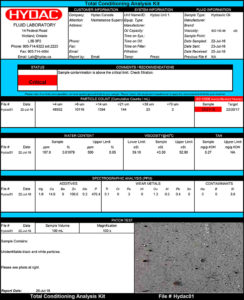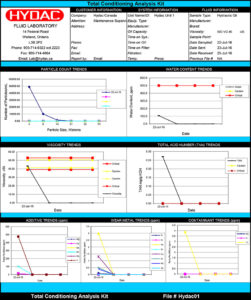Hydraulic fluid will have innate properties originating from its base stock, but will also contain additives to improve performance factors such as lubricity, corrosion protection, viscosity index and water saturation, to name a few. If a high quality hydraulic fluid came from the factory with excellent properties, how can we guarantee that oil hasn’t lost its excellence as it is exposed to hostile ambient and machine conditions?
Oil sampling is a process of analyzing fluid to test its condition and quality. Although some qualities, such as particle count, water saturation level and total acid number (TAN), can be measured live with electronic equipment, to gain full insight into the complex cocktail of chemical composition, physical properties and contaminants, an oil sample must be collected and then analyzed by a laboratory.
Oil can be sampled by dunking the sample bottle into the reservoir, but the accuracy of that sample could be limited if oil has already had the chance to settle out water and particle contamination, giving you a false sense of security. Ideally, oil should be sampled in the work stream, such as via a test point attached to the return line. This method ensures you have fluid sampled as seen by the hydraulic system, before water and particles can settle out.
Once sampled and returned to the lab, test are done to ensure the oil has the physical properties expected, and it also contains the additives you want without the contamination you don’t. Physical properties analyzed for are water saturation level (below 0.05%), TAN (level of oxidation), true viscosity (to compare to specified viscosity) and viscosity index (which is the measure of a fluid’s ability to maintain its specified viscosity over a wide temperature range).
Oil samples also measure for wear metals, providing you with information on components in your hydraulic system, and which might be wearing more than others. Analyzing for lead, iron, aluminum, copper or bronze, for example, will tell you if abnormal wear is occurring in any component containing those metals. Oil sample reports are trended, so previous analyses can show you if these components are wearing at an accelerated rate if there are data outliers.

 The most common reason to analyze fluid is to check the level of contamination affecting your hydraulic system. Particle and water contaminations are the two worst offenders that reduce the life of your hydraulic fluid and machine alike. The ISO 4406 particle count tallies the 4, 6 and 14 micron particles making up the bulk of the contamination, telling you not only how dirty your oil currently is, but how it compares to previous sample dates. Ensuring your oil contamination is less than the maximum requirement is the single most important thing you can do for the health of your machine. As well, keeping your water saturation below 0.05% ensures lubrication remains high and oxidation remains low, because humid oil oxidizes more rapidly, especially with added heat.
The most common reason to analyze fluid is to check the level of contamination affecting your hydraulic system. Particle and water contaminations are the two worst offenders that reduce the life of your hydraulic fluid and machine alike. The ISO 4406 particle count tallies the 4, 6 and 14 micron particles making up the bulk of the contamination, telling you not only how dirty your oil currently is, but how it compares to previous sample dates. Ensuring your oil contamination is less than the maximum requirement is the single most important thing you can do for the health of your machine. As well, keeping your water saturation below 0.05% ensures lubrication remains high and oxidation remains low, because humid oil oxidizes more rapidly, especially with added heat.
Finally, the standard oil additive package is measured for, and the presence of elements such as magnesium, zinc, phosphorous and molybdenum et al ensures internal components resist wear, reduce foaming and improve demulsibility. Additives also prevent corrosion, reduce varnish, and improve thermal stability. Any reputable oil testing facility will keep track of machine data, trending the samples to show how oil performance and quality changes over time, allowing you to react should something stand out. A well-planned oil-sampling and analysis program is cheap insurance considering the cost and complexity of today’s hydraulic machines.


Leave a Reply